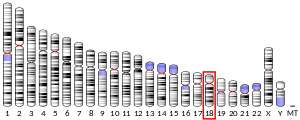CEP192
Centrosomal protein of 192 kDa, also known as Cep192, is a protein that in humans is encoded by the CEP192 gene.[5][6] It is the homolog of the C. elegans and D. melanogaster gene SPD-2.[7]
Cep192 is a major regulator of pericentriolar material recruitment, centrosome maturation, and centriole duplication in mammalian cells.[7] It stimulates the formation of the scaffolding upon which gamma tubulin ring complexes and other proteins involved in microtubule nucleation and spindle assembly become functional during mitosis.[8]
References
- 1 2 3 GRCh38: Ensembl release 89: ENSG00000101639 - Ensembl, May 2017
- 1 2 3 GRCm38: Ensembl release 89: ENSMUSG00000024542 - Ensembl, May 2017
- ↑ "Human PubMed Reference:".
- ↑ "Mouse PubMed Reference:".
- ↑ "Entrez Gene: centrosomal protein 192kDa".
- ↑ Andersen JS, Wilkinson CJ, Mayor T, Mortensen P, Nigg EA, Mann M (December 2003). "Proteomic characterization of the human centrosome by protein correlation profiling". Nature. 426 (6966): 570–4. doi:10.1038/nature02166. PMID 14654843.
- 1 2 Zhu, F.; Lawo, S.; Bird, A.; Pinchev, D.; Ralph, A.; Richter, C.; Müller-Reichert, T.; Kittler, R.; Hyman, A.; Pelletier, L. (2008). "The mammalian SPD-2 ortholog Cep192 regulates centrosome biogenesis". Current Biology. 18 (2): 136–141. doi:10.1016/j.cub.2007.12.055. PMID 18207742.
- ↑ Gomez-Ferreria, M.; Rath, U.; Buster, D.; Chanda, S.; Caldwell, J.; Rines, D.; Sharp, D. (2007). "Human Cep192 is required for mitotic centrosome and spindle assembly". Current Biology. 17 (22): 1960–1966. doi:10.1016/j.cub.2007.10.019. PMID 17980596.
External links
- Human CEP192 genome location and CEP192 gene details page in the UCSC Genome Browser.
Further reading
- Nagase T, Kikuno R, Nakayama M, et al. (2000). "Prediction of the coding sequences of unidentified human genes. XVIII. The complete sequences of 100 new cDNA clones from brain which code for large proteins in vitro". DNA Res. 7 (4): 273–81. doi:10.1093/dnares/7.4.271. PMID 10997877.
- Golsteyn RM, Mundt KE, Fry AM, Nigg EA (1995). "Cell cycle regulation of the activity and subcellular localization of Plk1, a human protein kinase implicated in mitotic spindle function". J. Cell Biol. 129 (6): 1617–28. doi:10.1083/jcb.129.6.1617. PMC 2291169. PMID 7790358.
- Zhu F, Lawo S, Bird A, et al. (2008). "The mammalian SPD-2 ortholog Cep192 regulates centrosome biogenesis". Curr. Biol. 18 (2): 136–41. doi:10.1016/j.cub.2007.12.055. PMID 18207742.
- Gomez-Ferreria MA, Rath U, Buster DW, et al. (2007). "Human Cep192 is required for mitotic centrosome and spindle assembly". Curr. Biol. 17 (22): 1960–6. doi:10.1016/j.cub.2007.10.019. PMID 17980596.
- Mayor T, Stierhof YD, Tanaka K, et al. (2000). "The Centrosomal Protein C-Nap1 Is Required for Cell Cycle–Regulated Centrosome Cohesion". J. Cell Biol. 151 (4): 837–46. doi:10.1083/jcb.151.4.837. PMC 2169446. PMID 11076968.
- Kimura K, Wakamatsu A, Suzuki Y, et al. (2006). "Diversification of transcriptional modulation: Large-scale identification and characterization of putative alternative promoters of human genes". Genome Res. 16 (1): 55–65. doi:10.1101/gr.4039406. PMC 1356129. PMID 16344560.
- Wiemann S, Weil B, Wellenreuther R, et al. (2001). "Toward a Catalog of Human Genes and Proteins: Sequencing and Analysis of 500 Novel Complete Protein Coding Human cDNAs". Genome Res. 11 (3): 422–35. doi:10.1101/gr.GR1547R. PMC 311072. PMID 11230166.
- Sowa ME, Bennett EJ, Gygi SP, Harper JW (2009). "Defining the Human Deubiquitinating Enzyme Interaction Landscape". Cell. 138 (2): 389–403. doi:10.1016/j.cell.2009.04.042. PMC 2716422. PMID 19615732.
- Takahashi M, Yamagiwa A, Nishimura T, et al. (2002). "Centrosomal Proteins CG-NAP and Kendrin Provide Microtubule Nucleation Sites by Anchoring γ-Tubulin Ring Complex". Mol. Biol. Cell. 13 (9): 3235–45. doi:10.1091/mbc.E02-02-0112. PMC 124155. PMID 12221128.
- Casenghi M, Meraldi P, Weinhart U, et al. (2003). "Polo-like kinase 1 regulates Nlp, a centrosome protein involved in microtubule nucleation". Dev. Cell. 5 (1): 113–25. doi:10.1016/S1534-5807(03)00193-X. PMID 12852856.
- Ota T, Suzuki Y, Nishikawa T, et al. (2004). "Complete sequencing and characterization of 21,243 full-length human cDNAs". Nat. Genet. 36 (1): 40–5. doi:10.1038/ng1285. PMID 14702039.
- Petretti C, Savoian M, Montembault E, et al. (2006). "The PITSLRE/CDK11p58 protein kinase promotes centrosome maturation and bipolar spindle formation". EMBO Rep. 7 (4): 418–24. doi:10.1038/sj.embor.7400639. PMC 1456919. PMID 16462731.
- Strausberg RL, Feingold EA, Grouse LH, et al. (2002). "Generation and initial analysis of more than 15,000 full-length human and mouse cDNA sequences". Proc. Natl. Acad. Sci. U.S.A. 99 (26): 16899–903. doi:10.1073/pnas.242603899. PMC 139241. PMID 12477932.
- Pope SN, Lee IR (2005). "Yeast two-hybrid identification of prostatic proteins interacting with human sex hormone-binding globulin". J. Steroid Biochem. Mol. Biol. 94 (1–3): 203–8. doi:10.1016/j.jsbmb.2005.01.007. PMID 15862967.
This article is issued from
Wikipedia.
The text is licensed under Creative Commons - Attribution - Sharealike.
Additional terms may apply for the media files.



